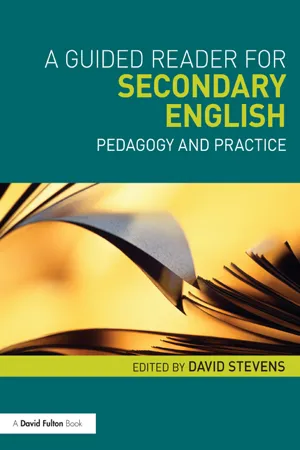Languages & Linguistics
Modern English
Modern English refers to the form of the English language used from the late 15th century to the present day. It is characterized by significant changes in vocabulary, grammar, and pronunciation, influenced by historical events, technological advancements, and cultural shifts. Modern English is the dominant global language, spoken by millions of people worldwide and serving as a lingua franca in many contexts.
Written by Perlego with AI-assistance
Related key terms
4 Key excerpts on "Modern English"
- eBook - ePub
- Joan C Beal(Author)
- 2014(Publication Date)
- Routledge(Publisher)
1 Modern English and modern times 1.1 Introduction: Defining ‘modern times’ ‘Modern times’ in this book are defined as the years from the beginning of the eighteenth century through to the end of World War II. This more or less coincides with the period generally referred to in more recent histories of English (e.g. Blake, 1996) as ‘Later Modern English’. Dates are always contentious in histories of English, and the boundaries of ‘Modern’ and ‘Later Modern’ English have long been, and are still, a matter of debate. In this chapter, I intend to demonstrate that the period covered is one in which the characteristics of both ‘Modern’ English and the modern world evolve. The term ‘Modern English’ with reference to a historical period seems to have been coined by Sweet in a lecture delivered to the Philological Society in 1873 and published in the society’s Transactions for 1873–4: ‘I propose … to start with the three main divisions of Old, Middle and Modern, based mainly on the inflectional characteristics of each stage’ (1873–4: 620). Since Sweet defined ‘Modern English’ as the period of lost inflections, there would be no need in his view for any further subdivision of this period, since the only inflection lost after the seventeenth century is the second-person singular - st. Writing at the beginning of the twentieth century, Wyld proposes a modification of Sweet’s threefold division, with Early Modern English ‘from 1400 or so to the middle of the sixteenth century’ and ‘Present-day English’ from the beginning of the eighteenth century to the time of writing (1920). Wyld is fairly typical of writers from the first half of the twentieth century in viewing the period from 1700 to what for them was ‘the present’ as coherent - eBook - ePub
- Ronald Carter(Author)
- 2012(Publication Date)
- Routledge(Publisher)
9 What is English? – Modern English language in the curriculum Michael Stubbs Introduction This article proposes a syllabus on Modern English language, suitable for secondary schools, colleges and universities. The syllabus is based on a substantial body of factual knowledge, a training in critical and analytic skills, and involves pupils and students in discussing problems which are socially, politically and morally important. English language in the modern world is clearly an important topic, given its hundreds of millions of speakers, and the powerful social, political and technological factors which affect it. The number of speakers of English has increased enormously in the last 200 years, and the new pressures on English mean that traditional ways of studying English are no longer always adequate. These new pressures include: its huge number of speakers and world-wide geographical spread; mass literacy and the mass media; the use of English as an international language against a background of enormous linguistic diversity. The article provides some facts about English in the modern world, and then proposes a syllabus for studying English language in an intellectually exciting way. The theme of the AATE Conference in Perth in 1979 was: What is English ? Since I was invited all the way round the world to address the conference, you might reasonably feel that I should have answered this question. And I did indeed feel under a considerable obligation at least to try and answer it. To answer the question, I would, of course, have had to understand what it meant, but I have to begin by admitting that it strikes me as a rather peculiar question. It seems a peculiarly fundamental question for an Association of Teachers of English to be posing - eBook - ePub
Language and Linguistics in Context
Readings and Applications for Teachers
- Harriet Luria(Author)
- 2012(Publication Date)
- Routledge(Publisher)
–est (for superlative). In addition, when new words are introduced into English, they are introduced as regular nouns and verbs, using the above inflectional suffixes to indicate plural and tenses. All the irregular plurals and verbs such as dreamt, meant, written, and children hark back to earlier stages of English.Sociolinguistics: Linguistic VarietiesWhat has caused English to change over the years, and in what ways has it changed most recently? To consider this question, we need to define sociolinguistics and how it relates to language change. Sociolinguistics is a term referring to the connections between language and society, and the way we use language in different social situations. It ranges from the study of the wide variety of dialects across a given region to the analysis of the way men and women speak to one another. Sociolinguistics shows us how a dialect of a given language can often describe the age, sex, and social class of the speaker; it codes the social function of a language. (Explore Linguistics, 1997).Included (among many other concepts) in the studies of sociolinguistics are the studies of dialects, registers, diglossia, and slang. Dialects are the individual varieties of a language spoken by different groups of speakers of that language. In general, they may be social dialects or geographical dialects. Social dialects include those spoken by particular ethnic groups and particular socioeconomic groups; examples would be AAVE (African American Vernacular English) and the Brahmin dialect of Massachusetts. Geographical dialects are spoken by groups of people in specific geographical areas, such as Australian English and Parisian French. Linguists distinguish the dialects of a single language from what are actually separate languages by their mutual intelligibility, or by whether speakers of one dialect can understand the speakers of another dialect of the language. This measure of distinction between languages and dialects can become a little slippery, however, in that some languages are more mutually intelligible than are some dialects of the same language. There are, for example, speakers of Flemish and Dutch who have an easier time understanding each other than do some speakers of American and Scottish English. What this represents is that not only does pure linguistics figure into what distinguishes a language from a dialect, but historical and political factors figure in, as well. Furthermore, all this having been said, one of the prime features of dialects to which politics and history contribute is that of what is the standard variety, or dialect, of the language—and which varieties, or dialects, are considered nonstandard by the majority of speakers. The standard dialect is generally the variety spoken by the educated, upper classes, whereas nonstandard varieties may be spoken by certain ethnic or socioeconomic groups, as well as in particular geographical areas. - eBook - ePub
A Guided Reader for Secondary English
Pedagogy and practice
- David Stevens(Author)
- 2012(Publication Date)
- Routledge(Publisher)
In the face of conservative appeals for legislation to force the ‘education establishment’ to teach traditional values, including a narrow and exclusive vision of grammar and Standard English (the subjects English and history were, arguably, the most contentious and controversial in this context), linguists and teachers called for rather different approaches. Bill Mittins, for instance, entitled his influential booklet, excerpted from here, Not the Naming of Parts, in opposition to the purely analytical teaching of language, separated from its contexts of actual use. He argued instead for a genuinely creative synthesis of approaches, dispelling widely held myths concerning the nature of language while so doing. Similar critiques may be found in the work of David Allen and Katharine Perera, celebrating language diversity and its inherently fascinating qualities. More recently, Debra Myhill reminds us powerfully that the debates are still very much ‘live’; indeed their relevance to current English classrooms is today even more urgent than it was two decades ago. Extract 1.1 Language is the creation and communication of meaning. Through language we remember the past, experience the present, and predict and plan the future. We experience the lives of others through language and give them accounts of our own. Through literature we extend these encounters so that we learn, and convey to others, lives, events and feelings beyond the limits of our daily world. Our own use of language is the nearest representation of ourselves that we commonly have. By their reaction to our words, others can hurt or heal us, foster or diminish us. Language gives us the ability to acquire knowledge, solve problems and give meaning to our existence. It forms an essential part of the process by which societies are formed and perpetuated. Individuals learn meanings from social situations in which they take part. Ultimately they pass on these meanings to others
Index pages curate the most relevant extracts from our library of academic textbooks. They’ve been created using an in-house natural language model (NLM), each adding context and meaning to key research topics.



